The caves of the Aggtelek Karst and Slovak Karst are situated on the border between Hungary and Slovakia, in the foothills of the Carpathians mountains. There are 712 caves in total in the Aggtelek Karst and Slovak Karst. Among the most notable caves are the Domica Cave in Slovakia and the Baradla Cave in Hungary, the Baradla Cave and the Domica Cave are connected by a 25 km long cave system. The caves of Slovakia are located in the Slovak Karst National Park, the caves of Hungary are located in the Aggtelek National Park. The caves were formed over millions of years. Several types of dripstone formations can be seen in the caves of the Aggtelek Karst and Slovak Karst, the caves also display a rare combination of tropical and glacial climatic effects and makes it possible to study the geological history over tens of millions of years. In the caves of the Aggtelek Karst and Slovak Karst rare flora and fauna can be found. A number of caves of the Aggtelek Karst and the Slovak Karst were added to the UNESCO World Heritage List in 1995. Together, the caves form a natural UNESCO World Heritage. World Heritage Art: Dripstone and In the Womb of Mother Earth
www.werelderfgoedfotos.nl © Copyright World Heritage Photos
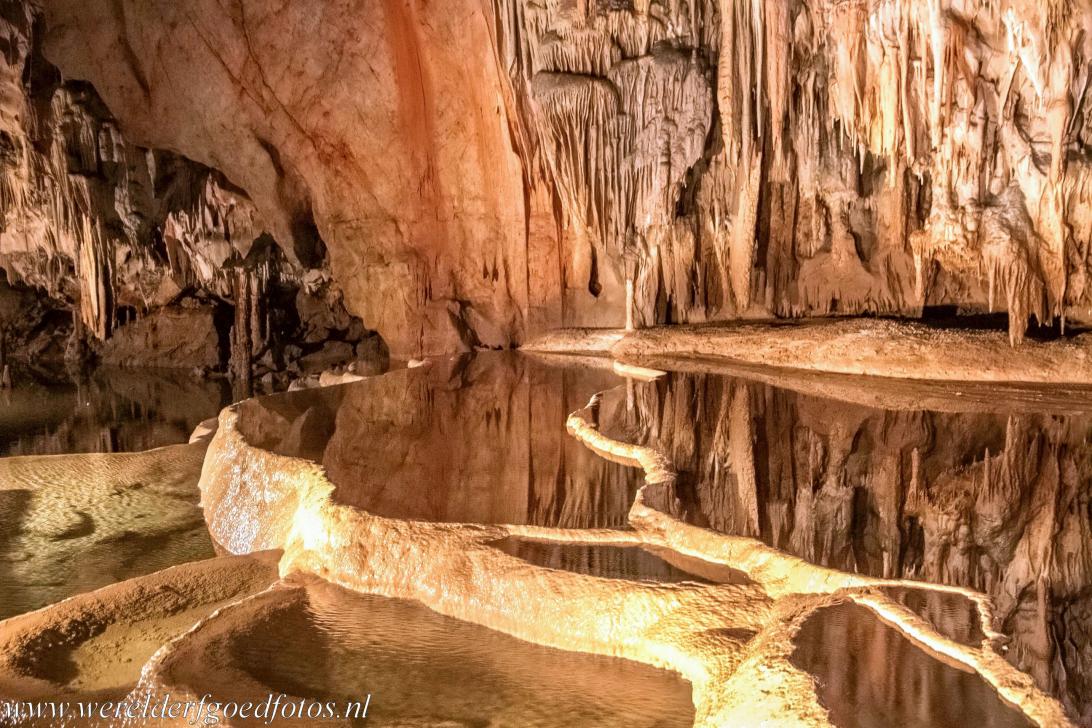
The caves of Aggtelek Karst and Slovak Karst: Reflections on the water of the cascade dripstone lakes of the Domica Cave in the Slovak Karst. In the dripstone caves of the Aggtelek Karst and Slovak Karst is the dripping water the sculptor. The Domica Cave was already a shelter for the oldest Neolithic inhabitants of eastern Slovakia and is also called the 'Cave of Prehistoric Man'. The Caves of the Aggtelek Karst and Slovak Karst became a UNESCO World Heritage in 1995.

The caves of Aggtelek Karst and Slovak Karst: Reflections on the water of the cascade dripstone lakes of the Domica Cave in the Slovak Karst. In the dripstone caves of the Aggtelek Karst and Slovak Karst is the dripping water the sculptor. The Domica Cave was already a shelter for the oldest Neolithic inhabitants of eastern Slovakia and is also called the 'Cave of Prehistoric Man'. The Caves of the Aggtelek Karst and Slovak Karst became a UNESCO World Heritage in 1995.
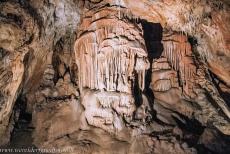
Caves of the Aggtelek Karst and Slovak Karst: The Domica is the biggest cave in the Slovak Karst. The dripstone cave is located near the border between Hungary and Slovakia. The cave is part of a large cave complex that continues into the Baradla Cave in Hungary. The Domica Cave and the Baradla Cave are connected by a 25 km long caves system. There are 712 caves in the Aggtelek Karst and the Slovak Karst.
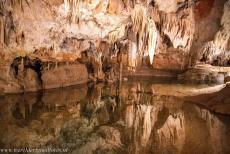
The caves of Aggtelek Karst and Slovak Karst: One of the cascade dripstone lakes of the Domica Cave in the Slovak Karst. The Domica Cave was formed by the course of two rivers, the Styx and Domica. The guided tour includes a short boat trip on the underground River Styx and a visit to several underground halls such as the Hall of the Chinese Pagodas with pagode-like stalagmites, the amazing cascade dripstone lakes, called the Roman Baths, and onion-shaped stalactites.
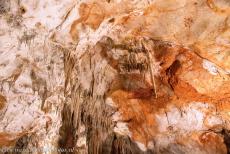
The caves of Aggtelek Karst and Slovak Karst: The coloured dripstone formations of the Domica Cave in the Slovak Karst. The Domica Cave was formed by the course of two rivers, the Styx and the Domica River. The Domica Cave derives its name from the Domica River. The reddish-brown and yellow colours of the dripstone are caused by the contamination of iron-oxide. Green is the colour of the algae and mosses and white is the colour of the pure lime stone.
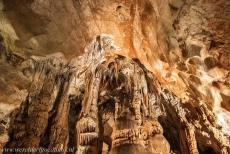
Caves of Aggtelek Karst and Slovak Karst: The unique salactites and stalagmites formations in one of the caverns of the Domica Cave in the Slovak Karst. The Domica Cave has a rich wildlife. About twenty cave-dwelling animal species have been discovered in the Domica Cave such as the Aggtelek blind amphipod and a blind water-slater. Several bat species also inhabit the cave, in winter as they are hibernating and in summer as they are mating.
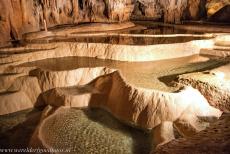
The caves of Aggtelek Karst and Slovak Karst: The cascade dripstone lakes in the Domica Cave. The green colour of the water is caused by microscopic algae. The Domica Cave is between 1.5 and 2 million years old. The Domica Cave was discovered in 1926 and already opened to visitors in 1932. The most important caves of the Aggtelek Karst and Slovak Karst are the Domica Cave in Slovakia and the Baradla Cave in Hungary.
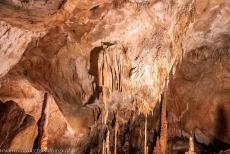
Caves of the Aggtelek Karst and Slovak Karst: Dripstone formations in the Slovak Domica Cave. A huge number of caves were added to the UNESCO World Heritage List in 1995, among them are the Domica Cave, the Dobšinská Ice Cave, the Krásnohorská Cave, known for housing the largest stalagmite in Europe, the Gombasecká Cave and the Ochtinská Aragonite Cave, renowned for its unique aragonite crystals that cover the walls of the cave like the stars of the Milky Way.
